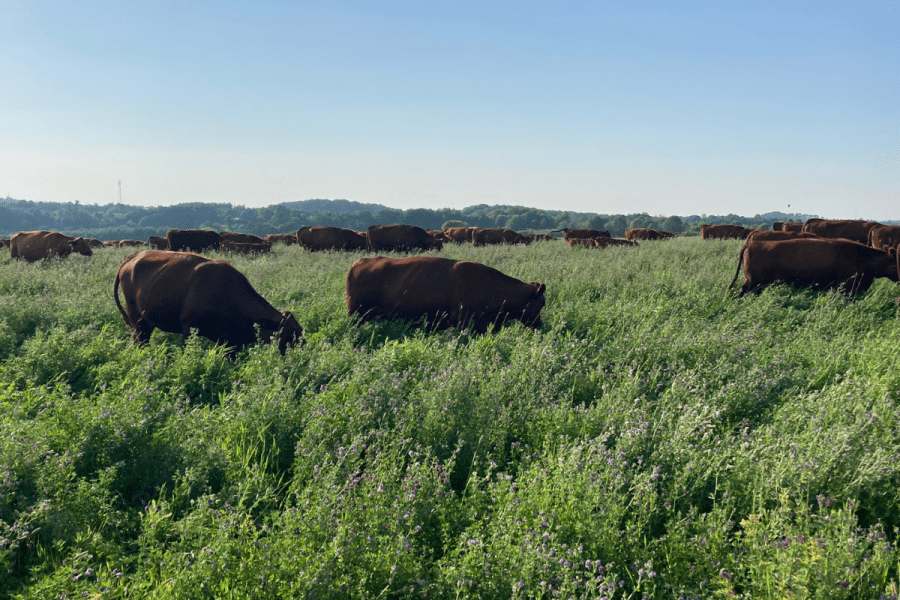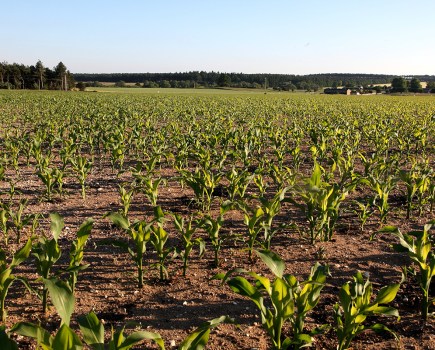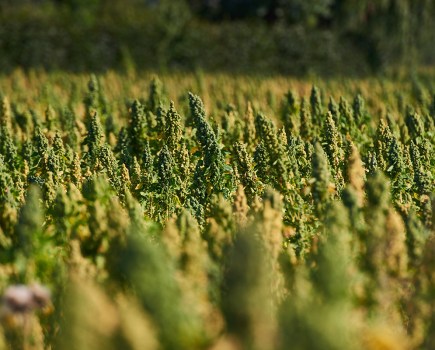How can growers cut greenhouse gas emissions on farm? Agronomist Chris Taylor’s Nuffield scholarship looked at how regenerative farming could help.
“Meeting net zero targets as an industry will be a balance of reducing greenhouse gas emissions, while also sequestering carbon”
By Mike Abram
Enough carbon footprints have been carried out on arable farms over the past few years for it to become obvious that addressing the two biggest emission factors – fuel and fertiliser – are going to hold to be a key to reducing agriculture’s impact on the environment.
“Around 60 to 70% of the greenhouse gas emissions on the average UK farm are coming from the production and application of nitrogen,” explains agronomist Chris Taylor. “Another 10-15% result from other fertiliser inputs, while 20% comes from fuel use.”
Understanding whether and how regenerative farming systems can address those two major emission factors became a key part of Chris’s Nuffield Farming Scholarship, which looked at the role regenerative farming could play in UK agriculture meeting net zero.
“Meeting net zero targets as an industry will be a balance of reducing greenhouse gas emissions, while also sequestering carbon. But I don’t think it enough for us to just rely on sequestration.”
He also feels strongly that net zero must be achieved while keeping both food production and farm profitability together.
“A lot of government plans seem to be about planting more trees and cutting livestock numbers. It’s more about shutting down farming and sequestering carbon in a way that changes land use.
“But when we’re expecting global populations to rise that doesn’t make sense to me. I feel farms are being steered towards a future where producing food is not their primary purpose, and I wanted to research whether regenerative agriculture system brought both productivity and profitability, and more of a land sharing approach.”
From Chris’s visits which took him to the USA, Canada, Brazil, France, Norway and Denmark, as well as to farms and conferences in the UK, he found plenty of evidence that regenerative farming could help tackle both fuel and fertiliser emissions, as well as contribute towards carbon sequestration.
For example, Jean Bruno, a French farmer from Moulins, showed Chris a split field. One-half he farmed on behalf of a landlord, the other side he was farming for himself. “The landlord wouldn’t let him use the same practices he used on his own land. So we walked across his half which was direct drilled with a John Deere 750a following sunflowers, and there were worm middens everywhere – it was covered in life with a dense mat of trash.
“The other side was where Jean had to plough begrudgingly and he’s kicking the soil saying it’s like the moon, it’s dead. He was savage that he’d had to plough this field he’d worked really hard to get into a no-till scenario.”
Equally stark were the differences in costs. Direct drilling with the John Deere 750a cost €80/ha and just 7 l/ha of fuel, according to Jean, while the plough and combi-drill has added about a €100/ha to establishment costs including an extra 38 l/ha of fuel.
“He was farming 400ha in combination with his neighbours and tenants, so I extrapolated these costs to his entire area and calculated the saving to switch to a no-till regenerative approach to be €40,000 and 15,000 litres of fuel, as well as a time saving, which is priceless in a catchy autumn or spring,” Chris says.
Switching to a no-till system, and indeed a wider regenerative system, needed careful planning, he learned in the US. “Many hear of many farmers in the US that have been using zero tillage for the past 20 or 30 years. What no one had told me before I went there was how they had earned the right to do that.
“I spoke to Dale Launstein, who farms in Iowa and spent eight years transitioning through strip-till before he started using no-till. He was suggesting he saved about 10 l/ha of fuel from moving to no-till from strip-till, which was saving him US$12,000 per annum on his 1200ha farm.
“He’d also seen his soil organic matter rise to between 3.5 and 5% where the local average was 2%.”
Those kind of fuel savings will be important step in helping arable farms reach net zero, he points out.
Planning such a transition in the UK also requires careful thought, he stresses, with strip-till potentially a good transition tool in our conditions as well.
“Some of the best farmers here that I’ve seen transition from a very traditional sort of establishment method to no-till have used strip-till, as well as rethinking their rotations slightly.
“There are also some easy wins. For instance, no-till winter wheat after beans works well, especially if you have strip-tilled the beans, so you’ve at least done a little tillage the previous spring.”
One conclusion Chris made through his trips was that regenerative farming was a system and that the principles couldn’t be cherry-picked or taken in isolation.
“I think it is easy to undermine the regenerative farming movement by perhaps practising two or three principles and claiming to be regenerative. That can be very misleading and undermines some of the best examples I came across in the world.”
In the best regenerative systems, it is hard to unpick what the farmers are doing into each of the five or six principles as they were all very much inter-linked, he says. “A very good example of keeping the ground covered, for instance, might be partly because the farm is no-till or very low disturbance.”
There wasn’t one “silver bullet” to reducing fertiliser requirements Chris found during his studies, but rotational change or fertility building cover cropping were perhaps the most common techniques farmers Chris visited were using.
“If growers had a hungry cash crop with a big nitrogen requirement, then they were looking to place generally a pulse crop or a fertility cover crop before it to reduce their carbon to nitrogen ratio and the nitrogen requirements for the following crop.”
In France, he visited a farmer who was growing oilseed rape after spring beans, which has the dual benefit of encouraging early growth of the oilseed rape crop as nitrogen became available, but also reducing the amount of applied nitrogen required by two-thirds.
“His traditional approach was to apply around 180 kgN/ha, which he’d managed to bring down to around 60 kgN/ha. Rotation planning like this offers a quantifiable way of reducing nitrogen inputs.”
Rotation adaption was often seen by farmers venturing into following regenerative principles as primarily there to help to adopt a regenerative principle, such as using zero-tillage, or agronomic challenge rather than to cut fertiliser use, Chris notes. “By doing that the fertility benefits came almost as a side benefit.”
That also applies to those using fertility building cover crops, which was another common practice that was helping to cut fertiliser requirements. “Some growers put in an overwintered cover crop followed by spring barley or spring oats rather than a winter crop because of blackgrass.
“They are then finding they have reduced their fertiliser requirements by 30-40% by growing a legume-based overwintered cover crop, or through capturing nutrients that would have otherwise been lost through runoff, leaching or erosion.
“I found people weren’t necessarily focused on cutting fertiliser use initially and had found them via a different way – they started off as fringe benefits before they realised the bigger picture.”
Talking to growers about cover crops helped Chris clarify the importance of carbon to nitrogen ratio in cover crops selection, and how that was crucial in understanding nutrient release. “It also really complemented management of cover crop residues.”
A visit to the Dakota Lakes Research Farm, operated by South Dakota State University, which has been using and researching regenerative farming practices since 1983, was particularly enlightening around how to manage cover crop residues.
“The farm is long-term no-till, with a particular focus towards soil and water conservation. South Dakota is reliant on capturing snow melt during and after winter, and conserving that during the dry spring and summer,” he explains.
“To do that they use a high residue cropping system – with an aim to grow at least 75% high residue crops in the rotation. What they felt they wanted was a soil surface with very little visible soil surface so it captures rainfall, prevent runoff and stopping too much leaching. The residue acts like a giant sponge and stops evapo-transpiration.”
Trials had shown the rotation provided very impressive infiltration potential. “Using Cornell University’s infiltration measurement where they subject the soils on the farm to a simulation of 250mm of rain in an hour, they had no runoff. It was all captured either in the soil profile or being absorbed by this residue mat on top to prevent any runoff.”
The Research farm puts its success down to how it manages the residue on the surface., Chris says. “But I quickly realised there were pros and cons because if you put in a nitrogen-hungry crop you were going to starve it and not get the best out of it.
“So this is where I realised we could manipulate residue levels on farm to maintain them if we’ve got a low requirement for nitrogen in the following crop, or to try and reduce them before a cash crop with higher nitrogen requirements to release fertility at the right time.”
In a UK context that helps simplify cover crop species selection depending on following crop requirements. “For example, I’ve started implementing cereal rye as a cover after winter wheat before a legume crop or maize in the spring.
“That puts in a high carbon to nitrogen ratio crop that will sequester more carbon. The lack of nitrogen fertility in the spring doesn’t matter that much as the legume crop will either fix its own nitrogen or, in the case of maize, will have a much lower inherent nitrogen requirement than a spring wheat, for example, perhaps partly because of use of organic manures.
“I’ve been using a lot of cereal rye before beans, peas or even lupins.”
Those covers are not necessarily just cereal rye, he adds. “I’ve been manipulating multi-species crops in the same way to have a higher carbon to nitrogen ratio. Cereal rye has just about the highest but it’s mostly about balancing species.”
In contrast, before a spring cereal or crop that has a higher nitrogen requirement, he’s growing cover crops with much lower carbon to nitrogen ratios, such as ones with vetches, burseem or crimson clovers.
“The penny drop moment was understanding for low carbon to nitrogen ratio covers the residue will not stay around for very long as soon as it is destroyed, while high carbon to nitrogen cover crop residues will hang around,” he concludes.
Living mulch replace cover crop option?
Living mulches of clover or lucerne were being used to cut N requirements, as well as provide other benefits, including potentially replacing cover crops.
Woody van Arkel in Ontario was finding clover understories were cutting N requirements, as well as providing ground cover to minimise weeds, capture sunlight and increase soil organic matters, Chris reports.
Frederic Larsen in Denmark used a similar approach with lucerne in oilseed rape. “He felt his living mulch of lucerne could replace cover cropping for four or five years, while retaining the benefits of cover crops with just one seeding and establishment cost.
“He said it was the perfect cover crop replacement with a low carbon to nitrogen ratio, which he could cut and sell to livestock producer, so he had a revenue coming in.
“It wasn’t going to replace as much N in his system as you might think – maybe 30-40 kgN/ha, but that could increase over time – it was very early in his system to know, he said.
“It was also competitive with his oilseed rape, so he was having to knock it back with chemicals, which was a challenging tight rope to walk.
“But I could see lucerne being a good option in the UK. It seems to come back quite readily after cultivation, but maybe it’s not quite as aggressive as white clover.”
Advice sector needs to catch up
While there are some good examples of agronomists, both independent and within distribution firms, of providing advice on how to implement regenerative practices on farm, in general the advice sector is still trying to catch up in the UK, Chris says.
Peer-to-peer learning from other farmers, not least through events like Groundswell, is quite often a key way farmers learn what works and what doesn’t when changing approach.
“The same applies in many parts of the world where peer-to-peer learning is crucial. In the US, for example, I heard about the Sussex Conservation District in Delaware, which ran a caffeine cover crops morning, a drop-in session for local farmers to talk to other farmers, who were soil health champions,” he says.
Advice in the US came mostly through research farms, such as Dakota Lakes and some university state extension services but it was in Denmark and Norway he found a model that could potentially be the blueprint for the UK.
“They had specialised companies offering advice on conservation agriculture which amounted to specialisms on direct drilling, cover crops, rotation and nutrient planning,” he explains.
There are some examples of similar already in the UK, such as Indigro, Hutchinsons agroecology department, Edaphos and RegenBen, but, in general, it is a tiny proportion of advisers compared with conventional agronomy. That’s slowing adoption on farm of practices that could cut greenhouse gas emissions, as well as improve profitability, Chris suggests.
Access to good training is lacking, mostly requiring individual investment or peer-to-peer learning, while business models and fear over risks of not using recommending products also are barriers to scaling regenerative approaches, he adds.
“I think there’s an opportunity for BASIS or another organisation to offer an industry-wide training course to create a known benchmark.”
This article was taken from the latest issue of CPM. Read the article in full here.
For more articles like this, subscribe here.
Sign up for Crop Production Magazine’s FREE e-newsletter here.




